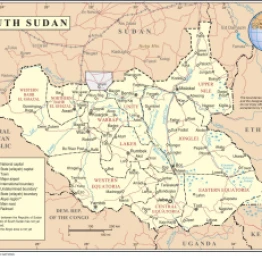For general information about the country profiles click here.
 Population: 10,837,527
Population: 10,837,527
HDI ranking: n.a.
HDI score: n.a.
The 2011 Interim Constitution of Southern Sudan (ICSS) declared a decentralized system of governance with three levels of government though the recent internal clashes has contributed to the central government consolidating power and rolling back on decentralization (ICSS, 2011; Kimenyi, 2012).
Local governance at a glance
-
The Local Government Commission, headed by a Chairman and supported by Board members, is responsible for overseeing the local government systems in the Republic of South Sudan (GOSS, 2014).
-
The Republic of South Sudan is comprised of three provinces—Bahl el Ghazal, Equatoria and Greater Upper Nile, which are subdivided into 10 States and 86 counties (localities) (Kimenyi, 2012; Maps of World, 2014).
-
The local governments tiers consist of County, Payam (district) and Boma (village) in rural areas, and city, municipal and town councils in urban areas. Each local government has two organs: the urban council and the rural council (AWEPA, 2012).
-
There are no local level quotas or reservations for women in South Sudan (Quota Project, 2014).
Civil society actors include
-
The Community Empowerment for Progress Organization (CEPO) works to bring the process of policy development in the legislature closer to the members of society. The organization also strives to make policy development processes more participatory in order to institutionalize accountability and transparency of government and leaders.
-
The Diar for Rehabilitation and Development Association (DRDA) is a community based organization specializing in rights awareness, literacy, health education and vocational skills training programs. DRDA works on projects such as community mobilization, information dissemination, education and preventative interventions.
Capacity building institutions
-
The Local Government Board (LGB) develops relevant concepts of local government systems that promote self rule at the local level, designs capacity development programs for local government authorities, coordinates local authority’s administration and service delivery, and prepares Local Government bills (GOSS, 2014).
Fiscal control
-
There is no established source of income and revenue for local governments in South Sudan, and local governments are dependent on intergovernmental transfers from oil revenue (Ichisaka, 2012).
-
In 2010, 97.8% of all government revenue came from oil, and the core fiscal policy of the government of South Sudan is to distribute its oil revenues to the other sectors and local governments (Ichisaka, 2012).
Key initiatives for participatory local governance
-
The Association of European Parliamentarians with Africa (AWEPA) in cooperation with South Sudan’s Legislative Assembly (SSLA) and State Assemblies are working on capacity building programs to contribute to achieving meaningful participatory leadership, good governance, accountability and improved service delivery in South Sudan through an effective legislature since 2007 (AWEPA, 2012).
-
The Local Government Act (LGA) 2009 sets the objectives for promotion of self-governance, enhancement of the participation of people and communities in maintaining law and order, promotion of democratic, transparent and accountable local government, encouragement of communities and community based organizations in local governance, and promotion of dialogue among local governments (AWEPA, 2012).
-
The ICSS (2011) has laid a foundation for a decentralized government, and transfer of power, authority and responsibilities to local governments, and there is an ongoing discussion on an anticipated new Constitution (AWEPA, 2012).
Challenges for participatory local governance
-
The most serious constraint to implementing a decentralized system of governance in South Sudan is the lack of administrative capacity at the national, state and local levels (Kimenyi, 2012).
-
There is lack of trained personnel to manage the public sector and to work in local capacity development. There is also a lack of equitable sharing of natural resource revenues among entities for essential services and for strengthening decentralized local government (Kimenyi, 2012).
-
There are very few institutions of local government outside the capital, Juba and in a few of the oil producing areas (World Bank, 2013).
-
The ongoing political crisis is believed to have contributed to the ruling party’s restructuring of the government into centralized government and rolling back the decentralization process (Kevin, 2014).
Recent posts on this website about this country:
______________________
List of sources (in order of citation)
Government of South Sudan (GOSS), 2011: “The Interim Constitution of the Republic of South Sudan”.
Kimenyi, Mwangi S., 2012: “Making Federalism Work in South Sudan”.
Government of the Republic of South Sudan, 2014:“Commissions”
Maps of World, 2014: “South Sudan”
AWEPA, 2014: “Background to Decentralization and the Local Government System in South Sudan”
Quota Project, 2014: “South Sudan”
Government of The Republic of South Sudan (GOSS), 2014: “Ministries of the Government of the Republic of South Sudan”
Ichisaka, Kohei, 2012: “Monetary and Fiscal Policy of South Sudan: Analysis of a Newly Independent Oil-Exporting Country”
World Bank, 2013: “South Sudan Overview”
Cope, Kevin, 2014: “South Sudan’s Constitutional Bait-and-Switch”
